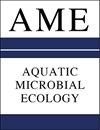海水粘度和温度对海洋鞭毛藻最小原心运动的影响
IF 1.1
4区 环境科学与生态学
Q3 ECOLOGY
引用次数: 2
摘要
重要的是要了解浮游鞭毛虫的运动如何受到环境条件的影响,包括那些可能受到气候变化影响的环境条件。由于其体积小,鞭毛藻可以预期对粘度的变化高度敏感;然而,目前对这些生物和其他藻类是如何受海水粘度调节的了解甚少。以前研究海水粘度对单细胞浮游生物的影响的工作从生物力学的角度考虑了不自然的大粘度变化,有时没有考虑温度的影响。我们研究了一种常见的沿海物种鞭毛藻(proorocentrum minimum)在暴露于环境相关温度和粘度变化时的游动。P. minimum对海水粘度和温度表现出加性响应:低温和高粘度均减慢了游动速度。海水温度和粘度对鞭毛藻的运动方向和游动线性没有影响。我们认为,与温度相关的运动变化可能部分受到粘度的机械响应的调节,粘度在低温下增加。我们还提出了未来实验室和模型研究的可能方向。本文章由计算机程序翻译,如有差异,请以英文原文为准。
Effects of seawater viscosity and temperature on the movement of the marine dinoflagellate Prorocentrum minimum
It is important to understand how planktonic dinoflagellate movements may be affected by environmental conditions, including those potentially influenced by climate change. Because of their small size, dinoflagellates can be expected to be highly sensitive to changes in viscosity; however, there is currently little understanding of how these organisms and other algae may be regulated by seawater viscosity. Previous work that has addressed the effects of seawater viscosity on single-celled plankton considered unnaturally large viscosity changes from a biomechanical perspective, sometimes without considering temperature effects. We studied the swimming of the dinoflagellate Prorocentrum minimum, a common coastal species, when exposed to environmentally relevant temperature and viscosity changes. P. minimum showed an additive response to seawater viscosity and temperature: cold temperature and high viscosity both slowed swimming speeds. However, seawater temperature and viscosity did not affect the movement direction or linearity of swimming of the dinoflagellates. We argue that temperature-related changes in movement may be partially regulated by a mechanical response to viscosity, which increases at cold temperature. We also propose possible future directions for laboratory and modelling studies.
求助全文
通过发布文献求助,成功后即可免费获取论文全文。
去求助
来源期刊

Aquatic Microbial Ecology
环境科学-海洋与淡水生物学
CiteScore
3.30
自引率
0.00%
发文量
8
审稿时长
3.0 months
期刊介绍:
AME is international and interdisciplinary. It presents rigorously refereed and carefully selected Research Articles, Reviews and Notes, as well as Comments/Reply Comments (for details see AME 27:209), Opinion Pieces (previously called ''As I See It'') and AME Specials. For details consult the Guidelines for Authors. Papers may be concerned with:
Tolerances and responses of microorganisms to variations in abiotic and biotic components of their environment; microbial life under extreme environmental conditions (climate, temperature, pressure, osmolarity, redox, etc.).
Role of aquatic microorganisms in the production, transformation and decomposition of organic matter; flow patterns of energy and matter as these pass through microorganisms; population dynamics; trophic interrelationships; modelling, both theoretical and via computer simulation, of individual microorganisms and microbial populations; biodiversity.
Absorption and transformation of inorganic material; synthesis and transformation of organic material (autotrophic and heterotrophic); non-genetic and genetic adaptation; behaviour; molecular microbial ecology; symbioses.
 求助内容:
求助内容: 应助结果提醒方式:
应助结果提醒方式:


